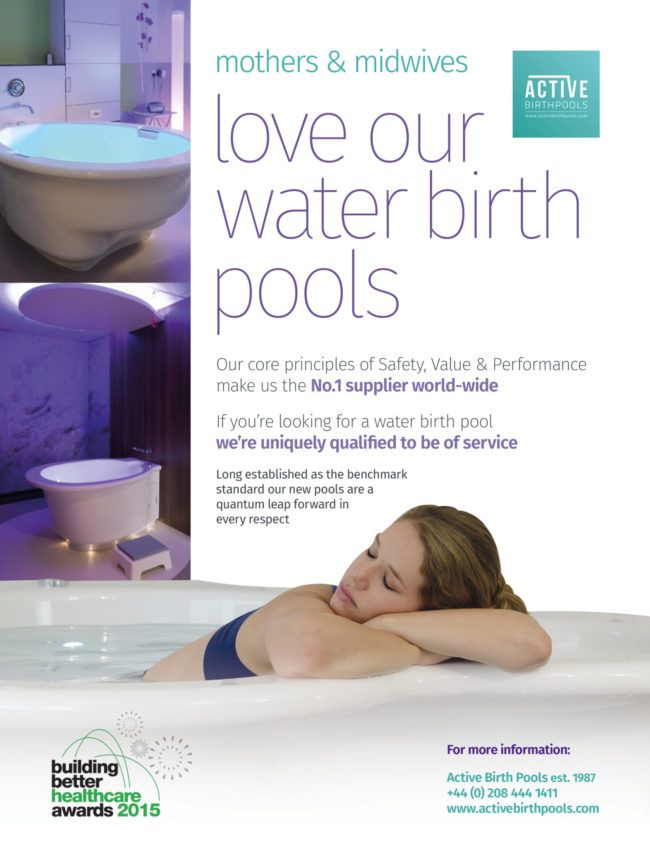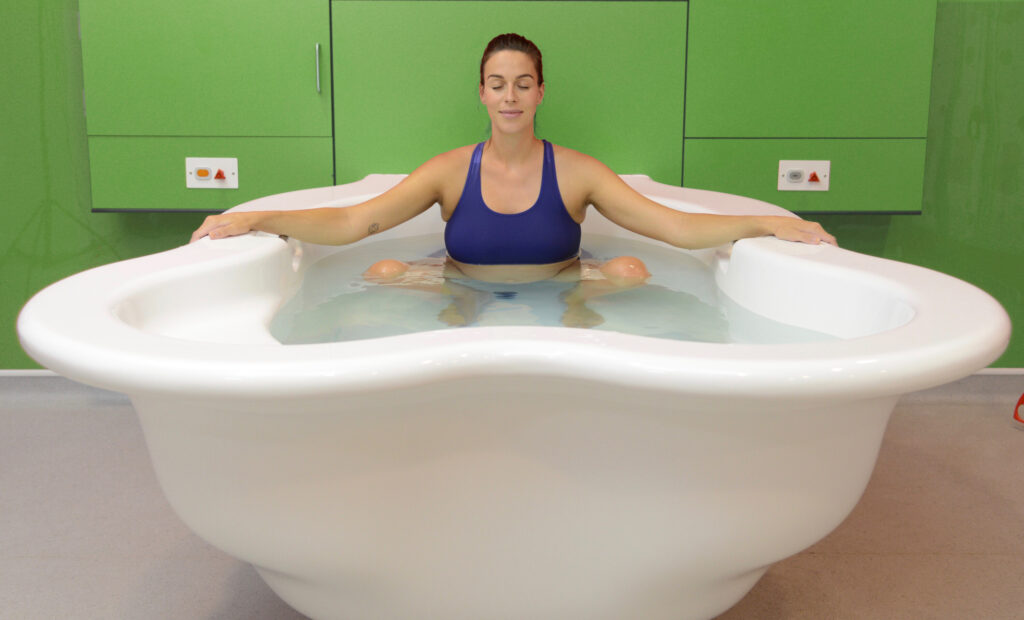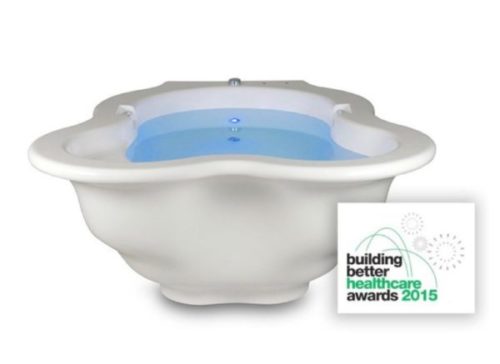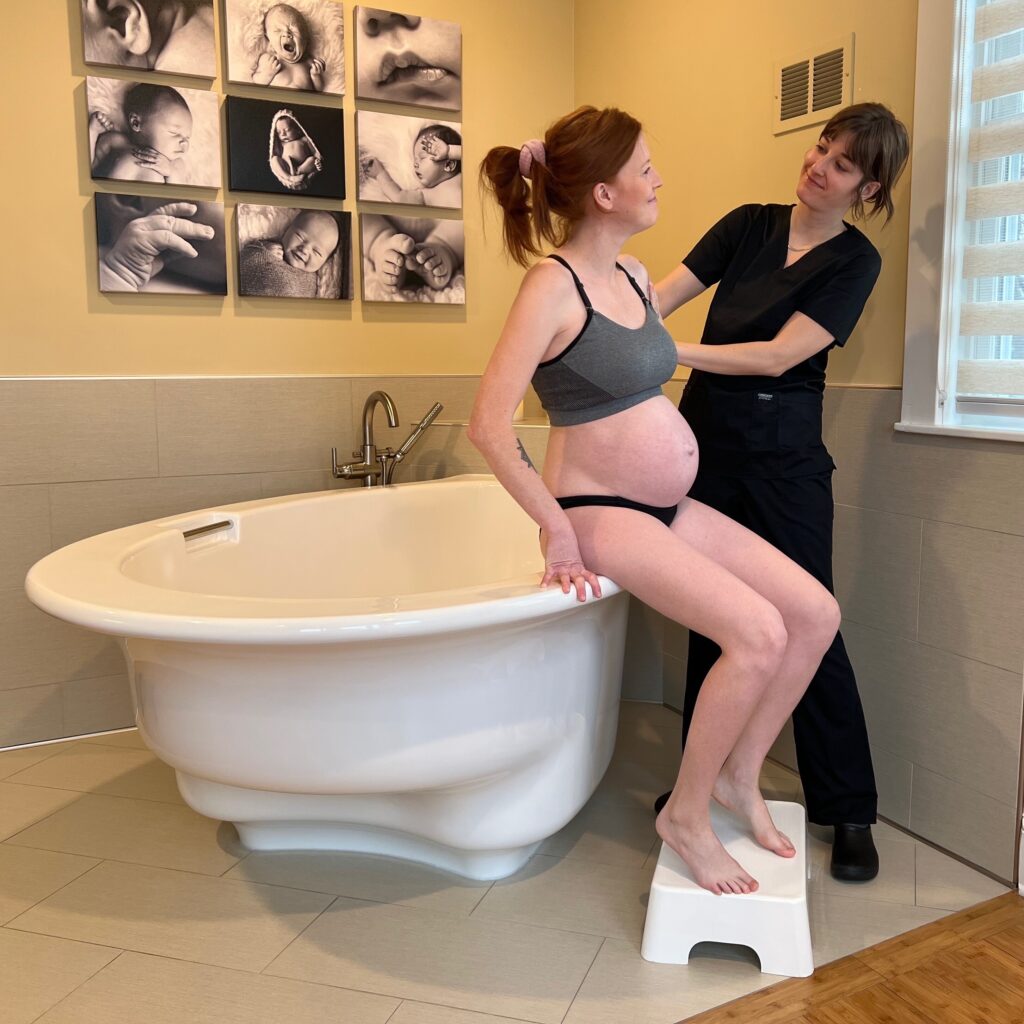This article first appeared in Midwifery Today, Issue 115, Autumn 2015.
There are many reasons to avoid last-minute cesarean sections that are decided at a phase of real emergency.
They are usually preceded by signs of fetal distress and they are often performed in poor technical conditions.
Furthermore, they are associated with negative long-term outcomes.
For example, according to an American study, women with a full-term second stage cesarean have a spectacular increased rate of subsequent premature births (13.5%) compared to a first-stage cesarean (2.3%) and to the overall national rate (7–8%) (Levine et al. 2014).
There are also serious reasons to avoid prolonged pharmacological assistance during labor, since the probable long-term effects of its different components (particularly drips of synthetic oxytocin) have never been evaluated through valuable scientific studies.
When a woman enters the pool in hard labor, there is an immediate pain relief, and therefore an immediate reduction in the levels of stress hormones.
Since stress hormones and oxytocin are antagonistic, the main short-term response is usually a peak of oxytocin and therefore a spectacular progress in the dilation.
We must add reasons to avoid, when it is possible, prelabor cesareans.
Apart from impaired lung maturation, it appears that the state of stress deprivation associated with “birth without labor” has a great variety of effects on the child, such as a lack of maturation of its olfactory sense (Varendi, Porter and Winberg 2002), which is a guide towards the nipple as early as the hour following birth (Odent 1977; Odent 1978).
Low levels of specific informational substances in the blood of stress-deprived neonates suggest effects on metabolic pathways and development of certain brain structures (Hermansson, Hoppu and Isolauri 2014; Simon-Areces et al. 2012).
It appears also that the milk microbiome and the gut flora of infants are disturbed in a specific way after birth by prelabor cesareans (Azad et al. 2013; Dogra et al. 2015), which is the mode of medicalized birth that disturbs breastfeeding more than all others (Prior et al. 2012; Zanardo et al. 2012).
Unexpectedly, it has been revealed recently that the risk of placenta previa in subsequent pregnancies is statistically significant only if the cesarean has been performed before the labor starts (Downes et al. 2015).
Finally, we are reaching a phase in the history of midwifery and obstetrical practices when an in-labor non-emergency cesarean appears in many cases as the best alternative to drugless childbirth.
In such a context, we understand the need for a new generation of tests in order to decide early enough during labor that the vaginal route is acceptable, without waiting for the phase of real emergency (Odent 2004).
The Basis for the Birthing Pool Test
The birthing pool test is the typical example of a tool adapted to futuristic strategies. It is based on a simple fact.
When a woman in hard labor enters the birthing pool and gets immersed in water at the temperature of the body, a spectacular progress in the dilation is supposed to occur within an hour or two.
If the already well-advanced dilation remains stable in spite of water immersion, privacy (no camera!) and dim light, one can conclude that there is a major obstacle. There is no reason for procrastinations. It is wiser to perform right away an in-labor non-emergency cesarean.
In the early 1980s, I had already mentioned in a mainstream medical journal (Odent 1983) the reason why we originally introduced the concept of birthing pools in the context of a French state hospital.
I had also described the most typical scenario: “We tend to reserve the pool for women who are experiencing especially painful contractions (lumbar pain, in particular), and where the dilatation of the cervix is not progressing beyond about 5 cm. In these circumstances, there is commonly a strong demand for drugs.
In most cases, the cervix becomes fully dilated within 1 or 2 hours of immersion…” At that time, I could only refer to most cases.
Afterwards, I analyzed the outcomes in the rare cases when the dilation had not progressed after an hour or two in the bath. I realized that finally a cesarean had always been necessary, more often than not after long and difficult first and second stages.
This is how I started to tacitly take into account what I had not yet called the birthing pool test.
More recently it happened that I mentioned the birthing pool test during information sessions for doulas.
This is how I learned from a series of reports about births in London hospitals.
It is obvious that many long and difficult labors with the usual range of drugs preceding an emergency cesarean would be avoided if the birthing pool test had been interpreted.
One of these anecdotes is particularly significant.
A woman in hard labor arrived in a maternity unit with her doula while the dilation of the cervix was already well advanced.
Soon after, she entered the birthing pool.
More than an hour later, the dilation had not progressed.
The doula, who was aware of the birthing pool test, was adamant that this woman could not safely give birth by the vaginal route.
A senior doctor was eventually called and diagnosed a brow presentation.
A brow presentation is difficult to diagnose in early labor and is incompatible with the vaginal route. In this case, the doula knew that a cesarean would be necessary, although she could not explain why.
The birthing pool test implies that an internal exam has been performed just before immersion so that, if necessary, a comparison will become possible after an hour or two.
This is an important practical detail, because midwives who are familiar with undisturbed and unguided births in silence, semi-darkness and privacy usually can follow the progress of labor with other criteria than a repeated evaluation of the dilation of the cervix.
Today, we can offer a physiological scenario explaining why immersion in warm water (set to the temperature of the body) makes the contractions more effective during a limited period of time.
When a woman enters the pool in hard labor, there is an immediate pain relief, and therefore an immediate reduction in the levels of stress hormones.
Since stress hormones and oxytocin are antagonistic, the main short-term response is usually a peak of oxytocin and therefore a spectacular progress in the dilation.
After that, there is a long-term complex response, which is a redistribution of blood volume.
This is the standard response to any sort of water immersion.
There is more blood in the chest (Norsk and Epstein 1988).
When the chest blood volume is increased, certain specialized cells in the atria release a peptide commonly called ANP (atrial natriuretic peptide) that interferes with the activity of the posterior pituitary gland (Gutkowska, Antunes-Rodrigues and McCann 1997).
We can all observe the effects of a reduced activity of our posterior pituitary gland after being in a bath for a while: we pass more urine.
This means that the release of vasopressin—a water retention hormone—is reduced.
In fact, the chain of events is not yet completely clarified (Mukaddam-Daher et al. 2002).
We have recently learned that oxytocin—the love hormone—has receptors in the heart (!) and that it is a regulator of ANP (Gutkowska et al. 1997).
In practice, we need to remember that the immediate peak of oxytocin following immersion in warm water will induce a feedback mechanism and eventually the uterine contractions will become less effective after an hour or two.
References:
- Azad, MB, et al. 2013. “Gut Microbiota of Healthy Canadian Infants: Profiles by Mode of Delivery and Infant Diet at 4 Months.” CMAJ 185 (5): 385–94.
- Dogra, S, et al. 2015. “Dynamics of Infant Gut Microbiota Are Influenced by Delivery Mode and Gestational Duration and Are Associated with Subsequent Adiposity.” MBio 6 (1): e02419–14.
- Downes, KL, et al. 2015. “Previous Prelabor or Intrapartum Cesarean Delivery and Risk of Placenta Previa.” Am J Obstet Gynecol 212 (5): 669 e1–6.
- Gutkowska, J, J Antunes-Rodrigues and S McCann. 1997. “Atrial Natriuretic Peptide in Brain and Pituitary Gland.” Physiol Rev 77 (2): 465–515.
- Gutkowska, J, et al. 1997. “Oxytocin Releases Atrial Natriuretic Peptide by Combining with Oxytocin Receptors in the Heart.” Proc Natl Acad Sci USA 94 (21): 11,704–09.
- Hermansson, H, U Hoppu and E Isolauri. 2014. “Elective Caesarean Section Is Associated with Low Adiponectin Levels in Cord Blood.” Neonatology 105 (3): 172–74.
- Levine, LD, et al. 2014. “Does Stage of Labor at Time of Cesarean Affect Risk of Subsequent Preterm Birth?” Am J Obstet Gynecol 212 (3): 360 e1–7.
- Mukaddam-Daher, S, et al. 2002. “Regulation of Cardiac Oxytocin System and Natriuretic Peptide during Rat Gestation and Postpartum.” J Endocrinol 175 (1): 211–16.
- Norsk, P, and M Epstein. 1985. “Effects of Water Immersion on Arginine Vasopressin Release in Humans.” J Appl Physiol 64 (1): 1–10.
- Odent, Michel. 1977. “The Early Expression of the Rooting Reflex.” In Proceedings of the 5th International Congress of Psychosomatic Obstetrics and Gynaecology, Rome 1977. 1117–19. London: Academic Press.
- ———. 1978. “L’expression précoce du réflexe de fouissement.” In Les cahiers du nouveau-né, vol. 1–2, edited by E Herbinet. 169–85. Paris: Stock.
- ———. 1983. “Birth Under Water.” Lancet 2 (8365–66): 1476–77.
- ———. 2004. The Caesarean. London: Free Association Books.
- Prior, E, et al. 2012. “Breastfeeding after Cesarean Delivery: A Systematic Review and Meta-analysis of World Literature.” Am J Clin Nutr 95 (5): 1113–35.
- Simon-Areces, J, et al. 2012. “UCP2 Induced by Natural Birth Regulates Neuronal Differentiation of the Hippocampus and Related Adult Behavior.” PLoS ONE 7 (8): e42911.
- Varendi, H, RH Porter and J Winberg. 2002. “The Effect of Labor on Olfactory Exposure Learning within the First Postnatal Hour.” Behav Neurosci 116 (2): 206–11.
- Zanardo, V, et al. 2012. “Impaired Lactation Performance Following Elective Delivery at Term: Role of Maternal Levels of Cortisol and Prolactin.” J Matern Fetal Neonatal Med 25 (9): 1595–98.









